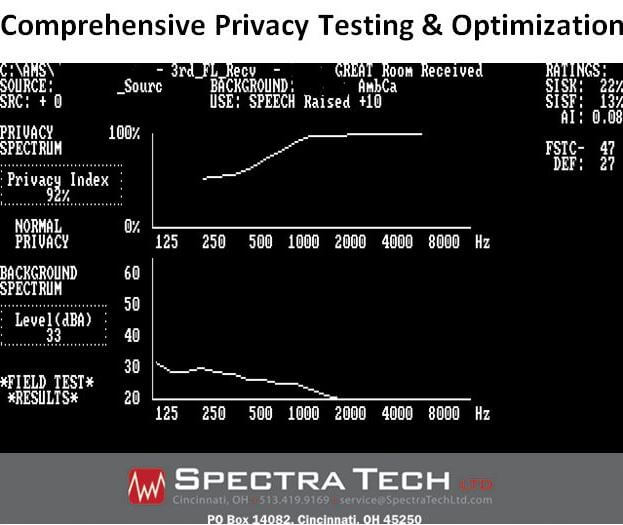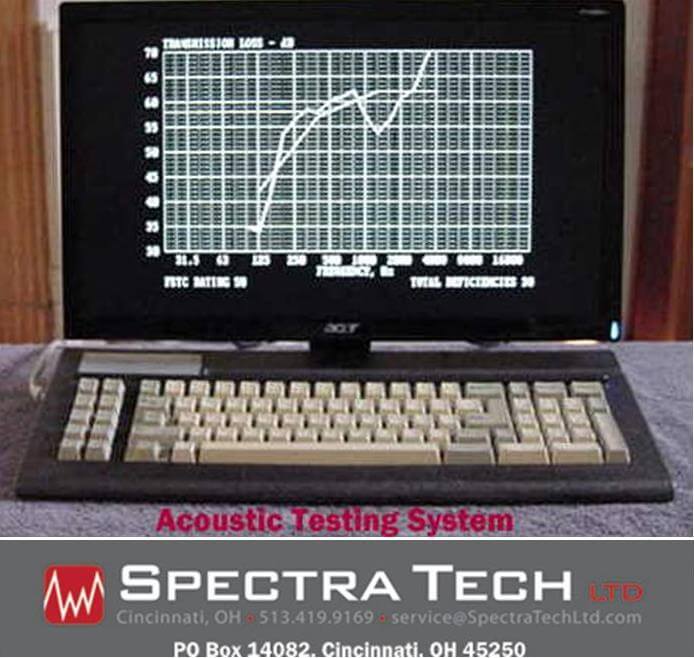Spectra Tech employes sophisticated equipment and software to measure and document Speech Intelligibility Indexes (SI, SISF, SISK)) values for open plan office spaces and other facilities where speech intelligibility or it’s inverse – speech privacy – are important considerations. We can also provide assistance in designing solutions to increase intelligibility or privacy.
- The Speech Intelligibility Indexes (SI, SISF, SISK) were developed to form a universal standard by which the intelligibility (or privacy) of speech within a given acoustical environment could be quantified.
- The Speech Intelligibility (SI) Index is a general measurement, providing a convienient method of rating a person’s ability to understand the spoken work within a given acoustical situation.
- The Speech Intelligibility of Sentences Known (SISK) Index is a measurement that raties a person’s ability to understand speech that they are familiar with (e.g., speech of a co-worker) within a given acoustical situation.
- The Speech Intelligibility of Sentences First Heard (SISF) Index is a measurement that raties a person’s ability to understand the speech that they are not familiar with (e.g., that of stranger) within a given acoustical situation.
- To test the Speech Intelligibility Index values between two locations, one must measure the “source” location sound level (normal speech, raised voice, music, etc), the sound attenuation provided by elements of intervening construction (walls, cubicles, etc), the background noise level at the “receiving” location.
- To determine the “source” sound level, a direct measurement can be taken at the location, or test data for typical sources previously documented can be used.
To test the transmission of sound through a particular construction, a broadband spectrum of noise is generated at all frequencies between 63 Hz and 8,000 Hz and amplified to provide a level at the receiving side that is sufficiently higher than the room’s normal ambient noise level. - The average unweighted (fast response) sound levels for each octave frequency band between 125 Hz and 4,000 Hz (4KHz) is recorded at ten random locations on the “source side” of the construction for a period of 10 seconds or more.
- The average unweighted (fast response) sound levels for each octave frequency band between 125 Hz and 4,000 Hz (4KHz) is recorded at ten random locations on the “receiving” location for a period of 10 seconds or more.
- A reverberation time test is also conducted in the “receiving room” and if the room reverberation is not found to be within the nornal criteria, adjustments to the rating must be made accordingly.
- Plot / Print Test Results: We can provide documentation of test results by plotting / printing the test values on paper, and / or provide the reslts in PDF format.


For a comprehensive list of acoustical measurement variables and criteria that can be measured and / or computed, please visit Detailed Measurement Specifications & Definitions
For specifications on our primary audio test equipment, please visit Audio Test System Specifications
LINKS TO RELATED REFERENCE INFORMATION
- ACOUSTIC PRIVACY, SPEECH INTELLIGIBILITY, AUDIO SECURITY, Office, Education, Residential, Spectra Tech Ltd, Consultant
- Onsite, On-site, Speech Privacy, Privacy, Testing, Sensitive Compartmented Information Facility, SCIF, Proves Its Value, Spectra Tech Ltd, Consultant
- Optimizing, Open Plan Office, Acoustic, Design, Spectra Tech Ltd, Consultant
- Potential, effect of reverberation on speech intelligibility, Spectra Tech Ltd, Consultant
- Acoustical Environment, Open-Plan Office, – 5 page publication – PDF format, Spectra Tech Ltd, Consultant
- Guide, Speech, Privacy, Test, Printout, Spectra Tech Ltd, Consultant

